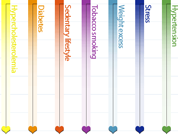Angina pectoris
Angina pectoris or angina defines chest pain that is a tightening “like clamp”, which may spreads to the neck, jaw, shoulders or arms, usually to the left arm. It is the result of a lack of blood, and therefore oxygen, to the heart muscle (myocardial ischemia), usually secondary to the constriction of a coronary heart vessel. One refers to this as coronary artery stenosis or occlusion. It is a common display of coronary heart disease. Certain patients may not have angina pectoris, in which case one uses terms such as silent ischemia (if it is transitory) or silent heart attack (if it is prolonged). This is more frequent in patients with diabetes.
Angioplasty
Coronary artery angioplasty is an intervention during which a small balloon is inserted into a coronary artery, via a catheter that is inserted into the femoral artery in the groin area, or the radial artery in the wrist, and then inflated. The inflation of this small balloon enables a narrowing of an artery to be dilated and therefore enables blood flow to be normalized. To improve angioplasty, a stent is often placed in the artery.
Atherosclerosis
This is a disease which affects all arteries in the human body and it develops over decades beginning in the teenage years. It is the accumulation of fatty streaks in the arterial walls – called atherosclerotic plaques – and leads to a narrowing of the arteries.
Coronary artery
Coronary arteries irrigate the heart and supply the heart muscle with all the energy and oxygen contained in blood, thus allowing the heart to function correctly.
Coronary artery angiography
This is the standard test used to evaluate various diseases linked to coronary arteries. It allows a visualization of these arteries. Small catheters are inserted into the femoral artery in the groin area, or the radial artery at the wrist, and pushed into the heart where a product is injected into the coronary arteries so as to see if there is a narrowing or occlusion. The injected product can be detected with X-rays.
Echocardiography
Echocardiography is echography of the heart, it is a medical imagery technique that uses ultrasounds to analyze the structure and function of the heart muscle and heart valves.
Electrocardiogram (ECG)
The electrocardiogram is a representation of the electrical activity of the heart. It is a rapid, painless and risk free exam that enables identification of heart muscle distress linked to coronary artery disease, or past signs of a heart attack.
Glycemia
This is the level of sugar in the blood, It is measured in grams of glucose per litre of blood, or in millimoles of glucose per litre of blood.
Myocardial infarction
This is a heart attack and represents necrosis (dead tissue) of parts of the heart, the latter of which is actually a muscle. It occurs when a coronary artery is blocked and therefore the heart muscle that depends on this artery for its blood supply no longer receives oxygen. This creates “distress” (which causes pain) and can lead to death if the artery is not opened in a timely manner.
Myocardium
Heart muscle
Coronary artery bypass graft (CABG)
This is surgery that usually requires the opening of the chest wall (thoracotomy) and the temporary arrest of cardiac activity. The aim is to use segments of arteries and veins from other parts of the body and to graft them onto the coronary arteries. Doing this creates a bypass of the areas which are narrowed or occluded by atherosclerosis.
Primary prevention
This involves patients who have never had a cardio-vascular event and who don’t’ have (or don’t know they have) atherosclerosis. It is a series of measures that decrease the risk of developing coronary artery disease.
Secondary prevention
This concerns patients who have already had a cardio-vascular event (such as a stroke, a heart attack, or lower limb arterial disease), or who have diabetes. It is a series of measures that decrease the risk of having a recurrence of events.
Stent
A stent is a metallic and tubular mesh (like a spring), that is inserted into an artery and opened with a balloon. It is placed during coronary artery angioplasty to help maintain a patient's artery.
Stress test
This is done on a bicycle or treadmill while the patient is connected to an ECG. The aim is to increase the heart rate by increasing the effort made by the patient. This is done by increasing the bicycle's resistance or the gradient on the treadmill every 3 minutes. It is stopped when the theoretical maximum heart rate is reached (Max. HR = 220 - age in years).
